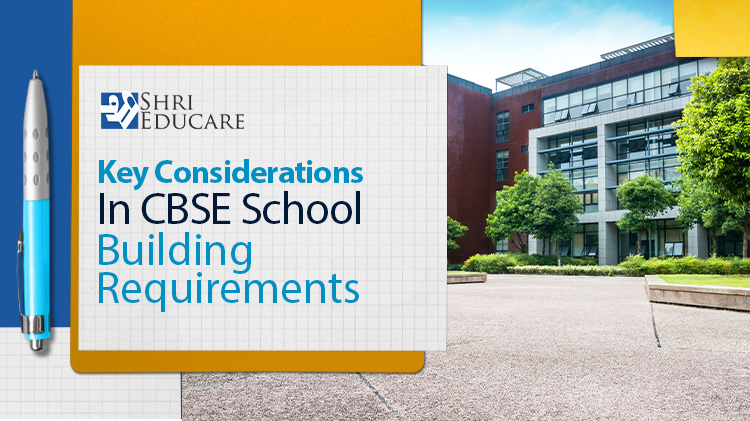A school building is more than just a physical structure; it is a vessel of knowledge, a sanctuary of growth, and a canvas for dreams! The impact of a well-designed school building on a child’s learning journey is immeasurable. From the layout of classrooms that foster interaction to the play areas that cultivate physical well-being, the environment in which education unfolds holds immense importance in the academic journey of students.
Central Board of Secondary Education (CBSE) recognizes the pivotal link between school infrastructure and quality education. Thus, it has come up with a set of guidelines for how schools should be built. They must have well-ventilated classrooms that make students feel invigorated, laboratories that ignite scientific exploration, libraries that hold a world full of stories, and much more.
In this blog, Shri Educare, the best school consultant in India, will help you explore the CBSE school building requirements, which will enable you to create the blueprint of your educational journey. So, let’s get started –
Understanding The Central Board of Secondary Education
CBSE is a national educational board in India that follows a standardized curriculum and assessment framework. It is renowned for its commitment to excellence and the holistic development of students. From pre-primary to high school, it offers educational programs that focus on academic rigor, co-curricular activities, and character building of students.
Now, let us take a look at the CBSE school building requirements to help you get your school in the best shape.
- Classrooms
In accordance with CBSE school building requirements, it is essential to ensure adequate space for optimal learning environments. Each classroom must have a minimum size of 8 m x 6 m (approximately 500 sq. ft.) to accommodate one section of students. This helps in guaranteeing sufficient space for teaching and other activities. Additionally, a minimum floor space of 1 sq. m per student must be maintained in order to promote comfort and mobility within the classroom.
These specifications prioritize the well-being of students, allowing them to thrive and engage effectively in their classes. In other words, meeting these dimensions will ensure that your school infrastructure is conducive to the holistic development of students, as outlined by the CBSE school building requirements.
- Science Laboratory
Science laboratories are where theoretical concepts come to life through hands-on experiments. Practical learning in these labs not only helps students grasp complex concepts better but also encourages their curiosity and critical thinking. Therefore, CBSE school building requirements stress the importance of well-equipped and safe science labs. According to these guidelines, a composite laboratory of 9 m x 6 m (approximately 600 sq. ft.) is required for a secondary school. And, for a senior secondary school, separate laboratories for physics, chemistry, and biology are required with modern tools and equipment that help students get practical learning.
- Library
As per the CBSE school building requirements, the establishment of a well-equipped and spacious library is paramount. The minimum size of your library should be 14 m x 8 m which will help in accommodating the student body. It must also offer a reading room and other resources to cater to the educational needs of the students.
In addition to that, it must house a comprehensive collection of books, encompassing age-appropriate books across subjects. The collection must also include e-books, Fiction, Non-fiction, Reference Books, Encyclopedias, Periodicals, Magazines, Journals, and Newspapers. You must encourage both staff and students to explore digital resources such as e-magazines, e-journals, and e-books.
The library should foster an inclusive environment, and the books should be issued to students regularly. This will help you enhance the learning experience of students while being in line with the CBSE school building requirements.
- Computer Laboratory
In today’s digital age, computer laboratories play an essential role in modern education. As per the CBSE school building requirements, the minimum size of such a lab should be around 9 m x 6 m (approximately 600 sq. ft.). And for effective learning, your school should maintain a computer-to-student ratio of 1:20, with a minimum of 20 computers available. It is also essential to have Internet connectivity with good speed.
Schools with up to 800 students must have at least one computer lab and additional labs should be set up for every additional group of 800 students, according to the CBSE school building requirements. If your school offers computer science or IT subjects at the senior secondary level, it is essential for you to have a dedicated laboratory with suitable provisions. And to ensure your students’ cyber safety, the lab must include appropriate measures. Also, they must enter the lab under the supervision of a teacher.
- Mathematics Laboratory
Mathematics often scares students, but a mathematics laboratory can change that! Therefore, CBSE school building requirements recommend this specialized space to transform abstract mathematical concepts into tangible experiences. Here, the students will be able to engage with puzzles, models, and interactive activities that will make math enjoyable and relatable for them. Also, it will encourage them to experiment, collaborate, and develop a deeper understanding of mathematical principles.
- Rooms For Extra-Curricular Activities
CBSE school building requirements also emphasize the need for dedicated spaces for artistic and physical activities. Therefore, your school must have separate rooms for music, dance, arts, and sports, or alternatively, a spacious multipurpose hall that accommodates all these activities. This will help you ensure a well-rounded education, fostering creativity and physical development in students.
- Drinking Water and Toilets
A healthy learning environment is incomplete without proper sanitation facilities. Thus, CBSE school building requirements emphasize the availability of clean drinking water and well-maintained toilets for both boys and girls. Additionally, separate restrooms should be made for staff and primary students. It is also essential for you to cater to the needs of physically challenged individuals with the help of specialized toilets. And, there should also be clear signage boards to help everyone find these facilities easily.
These CBSE school building requirements will not only help you promote good health but will also create a comfortable and welcoming atmosphere for your students.
- Facilities For Persons With Disabilities
In line with the CBSE school building requirements, your school must ensure inclusive facilities. These include ramps in toilets, which are designed for the convenience of wheelchair users, and auditory signals in elevators and lifts. These infrastructural adaptations will create an environment where everyone, regardless of physical abilities, will be able to access the school premises comfortably.
For more tips on how to create an exceptional learning environment that aligns with CBSE school building requirements, reach out to Shri Educare. We are the best school consultants in India who can help you provide holistic development to your students effortlessly!



